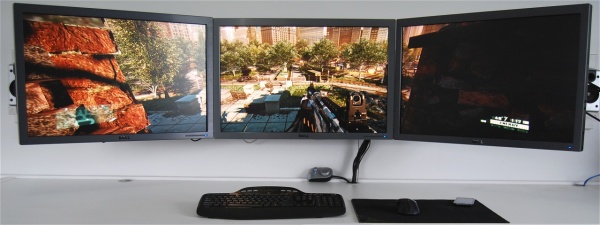With the release of the dual-GPU AMD Radeon HD 6990, closely followed by the competing Nvidia GeForce GTX 590 we saw graphics card performance reach new heights. With bandwidth throughput in excess of 300GB/s, these cards can consume more power than entire computer systems. Moreover, the two GPUs on board of either product are so complex that combined make up for 11,000 million transistors.
Generally speaking this type of graphics card is designed for the most demanding of PC gamers as they enable ultra high resolutions without even thinking about compromising visual quality. As of recent the only problem faced by gamers is that we haven't seen a great deal of computer games that really push the envelope, like the original Crysis game did, for example.
Many had expected Crysis 2 to be the game that would bring even the most power hungry gaming systems to their knees. Sadly the reality was far from it as Crysis 2 in its current condition is nothing more than a well polished DirectX 9 engine port.

What we describe has become a widespread practice in the industry with a majority of new PC game releases being console ports to one extent or another --- in the worst of scenarios to an overwhelming degree. Given the limited horsepower of today's console, which are now up to 5 years old, games designed with them in mind fail to stress modern PC hardware.
AMD and Nvidia have seen this coming and decided to get a little creative. AMD was the first to aggressively push multi-monitor support with their Eyefinity technology. Announced along the Radeon HD 5000 series, Eyefinity allows you to connect 3 or 6 monitors to a single graphics card. By supporting SLS (Single Large Surface) the technology is able to group together multiple monitors which the operating system recognizes as a single ultra high resolution screen.
Nvidia responded with Vision Surround when they launched the GeForce GTX 400 series. Vision Surround has been adopted by the GeForce GTX 590 and it's been a driving force behind this graphics card offering.
By utilizing three monitors games can become roughly 3x more demanding as the graphics card is required to render an overwhelmingly higher number of pixels. Whereas we commonly test graphics cards at single monitor resolutions of 1680x1050 (22"), 1920x1200 (24") and 2560x1600 (30"), today we are taking these and adding two more LCD monitors for effective resolutions of 5040x1050, 5760x1200 and 7680x1600.
We'll show you the kind of performance you can expect when playing nearly a dozen popular games using triple 22", 24" or 30" monitor configurations.